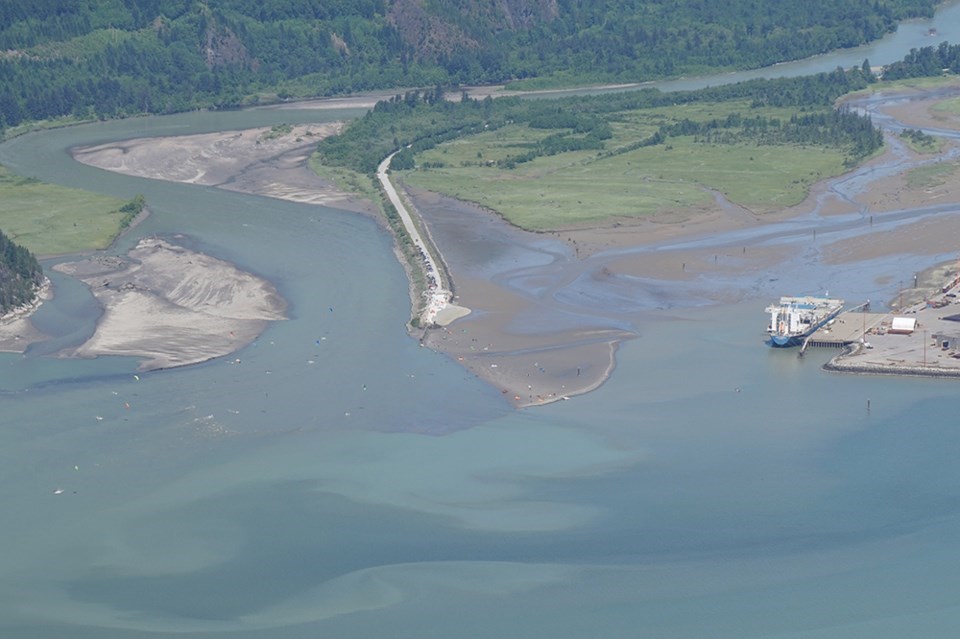I am writing with concerns around the plan to remove a section of the Squamish Spit ["Squamish kiters looking for a realignment solution for the Spit," published online March 12].
Coming from a family with deep roots in Squamish has fostered within me a love for this town, its animals, the natural environment, and the outdoor recreational opportunities that abound here. I believe that it is both possible and desirable to find a solution for the Spit that will provide for continued safe water access for community members while maintaining a healthy chinook salmon population.
Shortly after the construction of the Spit in the early 1970s, the local population of chinook salmon declined dramatically.
The groups responsible for the Spit removal plan point to the Spit as the sole or major contributing factor in the decline of the chinook population over the last 50 years. I am curious about this statement given all that has happened in Howe Sound since the 1970s. In that time, the sound has been contaminated by industry.
The Squamish Terminals were built in 1972, the same year the Spit was built. In the early 1970s, the seal population was at an all-time low with only 100 individuals counted in Howe Sound; since the implementation of a hunting ban in 1973, the seal population increased tenfold to 1000, and the sea lion population also increased; these are both predators of salmon.
Of course, the climate has also changed which has put new pressures on the salmon’s ability to survive and reproduce.
The good news is that, according to Ocean Watch Howe Sound in 2020, “preliminary observations suggest the [Tenderfoot Creek Hatchery chinook brood] program is on track to meet the intended conservational goals of bringing the populations back to historical levels”. Given all the contributing factors to the decline of the salmon, in addition to the success of the hatchery programs, is removing the entire Spit necessary, and is it the best move for the environment and our community?
The Spit is an area that is important to a lot of locals; it’s a place for people to congregate, socialize and share a common love for sports, for nature, and for this unique place. It is one of only two ocean access points in Squamish. Removing Spit access will have an enormous impact on our community, and I believe that this impact is worth more consideration than it is currently being given.
One of the user groups that Spit removal will affect most is kiteboarders. The Spit is a world-renowned kiteboarding destination, where the Canadian National Kiteboarding Championships are held each year. Kiteboarding is an eco-friendly sport that fosters a love for the ocean, and forms the foundation of a social community for many Squamish residents. Kiteboarding also brings visitors to our town who stay in local accommodations and eat in our restaurants and pubs.
Kiters will not stop kiting once Spit access is removed. Instead, a likely outcome is for many to turn to the use of motorized boats to launch in the Sound.
Removing Spit access could directly increase the amount of motorized boat traffic in Howe Sound, which is detrimental to all life in these waters, including salmon. Removing the Spit will also likely result in more rescues by community volunteers as well, as the Squamish Windsport Society will likely not be able to run its regular rescue service without access to the Spit. The risks and consequences to kiteboarders will be far greater.
Over the past few years the Squamish River Watershed Society has been working in partnership with The Department of Fisheries and Oceans, Squamish Nation, the District of Squamish and Squamish Windsports Society to create a plan for realignment of the Spit and estuary restoration; the SWS says removing the Spit fully was not on the table in these discussions.
However, in mid-February it was suddenly announced that a decision had been made to remove the Spit completely, on a very short timeline.
This left no time for community members to fundraise for a solution that would meet all stakeholders’ needs. I question whether a non-profit organization should be able to have such powerful influence on an entire local community’s ocean access, and their sightseeing and recreational opportunities, without public discourse.
Given time, a solution can be reached that will help the salmon to thrive and will also preserve one of the few ocean access points in Squamish. This unique piece of our community should not be removed without time for more research, more input from all stakeholders, and the opportunity to raise funds for a solution.
I strongly urge the parties involved to reconsider the decision to remove the Spit this year, and to allow for the opportunity to create a community plan that meets the needs of both the salmon and our community members.
For further information about Spit realignment options and what you can do to help, please visit realignnotremove.ca
Kaida Fieldhouse
Grade 11 student, Squamish




